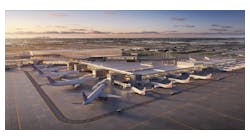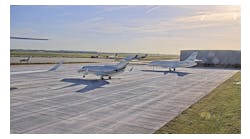Airports Council International (ACI) World released its 2021 World Airport Traffic Report (WATR), along with data showing the lasting impact of COVID-19 on air transport demand.
According to the report, the COVID-19 outbreak reduced the number of passengers at the world’s airports by more than 5.6 billion in 2020 and is forecast to remove an additional 4.6 billion passengers by the end of 2021, compared to 2019 volumes. Global passenger traffic in 2021 is expected to reach only half of what it was in 2019, totaling only 4.6 billion of the 9.2 billion passengers served two years ago.
The world’s airports also saw a sharp reduction in global aircraft movements in 2020, decreasing by 39.5% to reach only 62 million.
The pandemic, however, had a less severe impact on global air cargo volume, largely driven by the requirement for personal protective equipment (PPE) and the increase in online retail. Nevertheless, global air cargo declined by 9.6% in 2020 compared to 2019, with 108 million tonnes handled in 2020.
Global passenger traffic: Domestic traffic leading recovery
Due to COVID-19-related travel restrictions worldwide, domestic passenger traffic continues its trend from 2020 into 2021 of recovering faster than the international market — especially in China and in the U.S., the latter being the world’s largest domestic market. Globally, domestic traffic will continue to increase in 2021 to reach more than 3.1 billion passengers by the end of the year, a level corresponding to 58.5% of that achieved in 2019.
The U.S. is now home to only three of the top 10 busiest airports in the world, Chinese airports filling the seven other top positions in 2020. Traffic at Atlanta (ATL) — which had been the world leader for passenger traffic since 2000 — fell 61.2% in 2020, causing it to cede the top spot to Guangzhou (CAN) as the world’s busiest airport for passengers. Dallas/Fort Worth (DFW), the world’s tenth-busiest airport in 2019, moved up to fourth-busiest in 2020.
Before the pandemic, four of the 10 busiest airports in Asia-Pacific were Chinese airports. As a result of the COVID-19 outbreak and then the rapid recovery of its domestic passenger market, seven airports in China now reside in the top 10, six of them new to the list. Many Asia-Pacific international hubs suffered major losses due to their dependence on international passenger traffic and did not make the top 10 in 2020, such as Beijing (PEK), the busiest airport in 2019, and Tokyo (HND), the second-busiest airport in 2019.
The Asia-Pacific region covers a sizeable geographical area, however, and has recently shown some signs of a slower than expected recovery. This is due to many countries remaining closed to international travel, inevitably impacting all regions — as Asia-Pacific has been the main region driving growth in the global air transport industry over the last decade.
Global cargo traffic: Fueled by PPE, vaccines and online retail
Despite the general feeling that air cargo volume boomed in 2020 because of the requirements for personal protection equipment (PPE) and later for vaccine shipments, the decrease in passenger aircraft movements — which severely limited the availability of belly-cargo capacity — offset gains from shipments of PPEs and online retail merchandise.
According to the report, about 11.5 million metric tonnes less of air cargo were carried in 2020, returning the industry to 2015–2016 tonnage levels, and the COVID-19 crisis is expected to remove more than 3.6 billion passengers for 2022, representing a 28.3% decrease from 2019 levels.
The performance of individual airports in the top 10 busiest cargo hubs differed significantly from 2019 rankings. Memphis (MEM), the global hub for FedEx, saw volume grow 6.7% in 2020. Its growth helped MEM take the top place in 2020 reclaiming the No. 1 ranking held by Hong Kong (HKG, down 7.1% in 2020) since 2010. Shanghai (PVG, up 1.4%), Anchorage (ANC, up 15%), and Louisville Muhammad Ali International Airport (SDF, up 4.6%) — home of another major consolidator, United Parcel Service — complete the top five busiest airports for air cargo. Airports heavily used by all-cargo carriers or major consolidators experienced much better performance in 2020 compared to airports relying on international passenger movements for belly cargo capacity.
“The impact of COVID-19 has completely altered the airport sector as seen in the busiest passenger and cargo traffic rankings,” ACI World Director General Luis Felipe de Oliveira said. “The 2021 World Airport Traffic Report provides in-depth analyses into the impact of the pandemic on airport passenger, movement, and cargo traffic from a global and regional perspective — enabling airport stakeholders to make data-driven decisions as airports and the aviation sector work towards a sustained long-term recovery.
“The economic value driven by airports cannot be understated when it comes to facilitating business and leisure travel, trade, and the subsequent GDP, jobs, taxes and associated social benefits. Air traffic is the lifeblood of the airport business, highlighting the necessity of government action to promote safe travel — including a coordinated and risk-based approach to testing and vaccination — rather than enforcing full-scale restrictions and blanket measures.”
To highlight the resiliency and rich past of the sector, for this year’s report, ACI World has collaborated with AirportHistory.org to provide “time capsules” that depict the history of eight airports spread over six continents. Each capsule contains a selection of carefully curated images from the AirportHistory.org archives as well as historical facts that exemplify the evolution of the industry.





